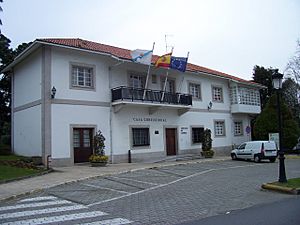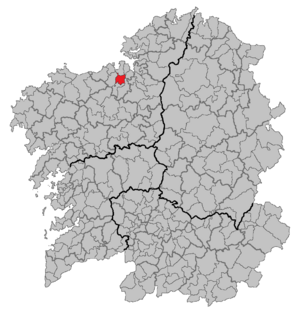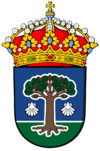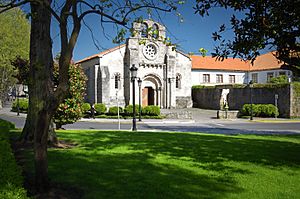Cambre facts for kids
Quick facts for kids
Concello de Cambre
|
|||
|---|---|---|---|
 |
|||
|
|||
| Nickname(s):
Cambre
|
|||

Location of Cambre within Galicia
|
|||
| Parroquias | Anceis, Andeiro, Brexo, Bribes, Cambre, Cecebre, Cela, Meixigo, Pravio, Sigrás, O Temple & Vigo | ||
| Area | |||
| • Total | 41 km2 (16 sq mi) | ||
| Population
(2018)
|
|||
| • Total | 24,603 | ||
| • Density | 600/km2 (1,554/sq mi) | ||
| Time zone | UTC+1 (CET) | ||
| • Summer (DST) | UTC+2 (CEST) | ||
| Website | http://www.cambre.org/ | ||
Cambre is a town in northwestern Spain, located in the Galicia region. It's about 12 kilometers (7.5 miles) from the big city of A Coruña and close to its airport, Alvedro.
In 2010, Cambre had about 23,621 people living in its 12 smaller areas called parishes. These parishes cover an area of 41 square kilometers (16 square miles). Some of the parishes include O Temple, Cambre, Sigrás, and Cecebre. Cambre shares its borders with the nearby towns of Culleredo, Carral, and Oleiros.
Cambre has many interesting places to visit. These include an old church, a museum with Roman artifacts, and the house of a famous Galician writer. The town is also part of the Way of St. James (Camino de Santiago), a famous pilgrimage route. Specifically, it's on the "English Way," which pilgrims from England and Ireland used to take by ship.
Contents
What Does the Name Cambre Mean?
The name Cambre might come from "Calambre" or "Calamber." It was first mentioned when the Church of Santa María was built around the 12th century. Some people think the name was given by the Knights Templar. This was a Christian group formed long ago. They built a fortress near Cambre, which is now gone. One of Cambre's parishes is even named Temple in their honor.
However, there are other ideas about where the name came from. Some suggest it's linked to "Cambria," which sounds like Cymru (the Welsh name for Wales). This idea suggests that Welsh vikings might have visited the area many centuries ago. This theory is more of a legend, but it connects the Celtic people of Galicia with those of Wales. When the Romans arrived in this part of Spain, they called the area Galicia. This name, and the word Galegos (people from Galicia), comes from Gales, which means Wales in many languages.
Cambre's Long History
People lived in the Cambre area a very long time ago, even during the Castro culture. You can still see parts of their old settlements, called castros, which had defensive walls. The Castro of Sigrás is a good example.
The Romans also had a presence here. Cambre was likely on a Roman road that connected important Roman towns. After the Roman Empire fell, the area was protected by the Suebi people. But Roman culture stayed strong, and the Suebi influence is mostly seen in a few town names today.
Later, the coastal areas faced attacks from the Normans and then from Muslim groups from the south. Cambre became more important around the 12th century, thanks to the Knights Templar. One of Cambre's parishes, El Temple, has a Romanic church from this time and a 14th-century bridge. These show that the area was growing a lot.
After many battles in nearby A Coruña, many people moved inland along the River Mero. Cambre grew even more with the help of three kings who had strong ties to Galicia: Alfonso VII, Ferdinand II, and Alfonso IX. These kings helped build many churches and bridges in the area.
In later centuries, Cambre's story was similar to most towns in Galicia. Galicia became part of the Crown of Castile. Its culture saw a comeback in the 19th century. This cultural growth slowed down during the time of General Francisco Franco's rule. But in recent years, millions of tourists have visited Galicia, especially Santiago de Compostela.
Beautiful Pazos in Cambre
Cambre is also known for its beautiful Pazos. These are old country estates that belonged to the nobility. Some of the most impressive ones are found in San Xiao de Cela, San Paio de Brexo, San Martiño de Andeiro, and San Xoán de Pravio.
Places to Visit
- The Cambre Roman Villa: This old Roman site is now a small museum where you can learn about Roman life.
See also
 In Spanish: Cambre para niños
In Spanish: Cambre para niños




